NECO 2022 GEOGRAPHY ESSAY
_ANSWER TWO QUESTIONS FROM EACH SECTION_
*SECTION A*
(1a)
A conurbation is a region comprising several metropolises, cities, large towns, and other urban areas that, through population growth and physical expansion, have merged to form one continuous urban or industrially developed area
(1b)
(i) Shortage of residential housing: Conurbation allows the movement of people from the rural areas to the cities and towns which in turn results in population increase. An increase in the number of people living in urban areas often results in continuous scarcity of houses and a large sparse of land is also demanded further spread of settlement.
(ii) Increasing levels of pollution: Pollution of air, land and water is a major problem in most developing world cities. The drive to industrialisation brings with it inevitable problems, especially as legislation to protect the environment is often non-existent or rarely enforced. Furthermore, the hidden economy can add to the levels of pollution as small, unlicensed industries are set up in people’s homes or on rooftops. These industries release their pollutants into the air, land and water.
(iii) High Rate of Unemployment:
The number of people living in cities who are capable of working is higher than the number of jobs available. As more people flood the cities in search of elusive jobs, the unemployment rate keeps growing. A significant percentage of Nigerian youths are unemployed and most of them stay in urban areas
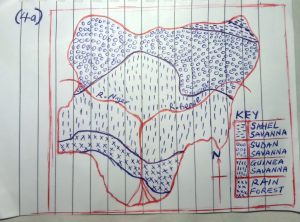
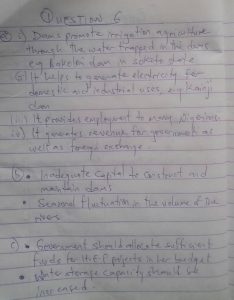
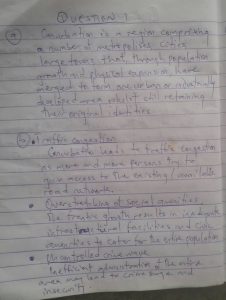
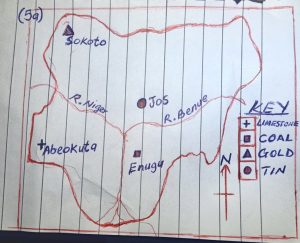
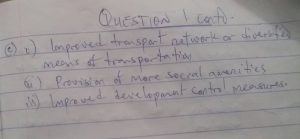

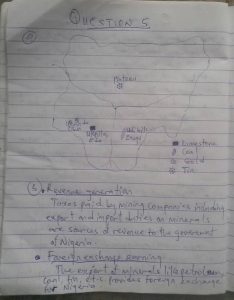

(1c)
(i) Housing development: Provision of more houses and social amenities at affordable rates to the people
(ii) Pollution control: Industrial areas should be created to limit the areas where industrial emissions are produced. Governments should aslo develop some strict laws guiding refuse dumping in an open environment
(iii) Creation of employment opportunities: Government should create more jobs by establishing industries, supporting private investors, and should encourage entrepreneurship by providing more funds in the city.
===========================
(2a)
(i) Lack of Proper Drainage Facilities:
Erosion which is caused by a lack of proper drainage facilities such as gutters is another major thing that has destroyed the state of Nigerian roads. Proper drainage facilities should be made available along with road networks so that water would no longer settle on the roads and wash away the asphalt surface.
(ii) Poor State of Roads:
This is one of the major problems faced in this means of transportation. The majority of the roads are left in very bad shape as a result of erosions, portholes and inadequate drainage systems. The roads with potholes and uneven edges or surfaces make transportation not only difficult and stressful but also dangerous as some of those roads are from major sites of accidents.
(iii) Effects of Climate Change:
Climate change has an impact on road transportation. Increased temperatures can make pavements soften and expand. This can create potholes, especially in high-traffic areas and can cause bridge joints to become stressed. These impacts can make the construction and maintenance of roads and highways very expensive.
(iv) Lack of proper maintenance:
Poor land transport system maintenance is a major problem contributing to the poor state of transport infrastructure. The government fails to attend to them on time. Due to poor maintenance and low-quality materials, which have been used for repairs, over time the condition of such roads keeps getting worse.
(2b)
(i) Land transportation is substantially cheaper compared to air transportation
(ii) Land transportation is more suitable for shorter distances and provides easy access to rural areas
(iii) Land transportation provides easy door-to-door and flexible services
(iv) Land transportation is adequate for moving goods in relatively smaller quantities and requires less packaging.
(2c)
(i) Mobility of Labour and Capital:
Transport reduces the rigours of immobility of certain factors of production. Mobility of labour and capital increases with the development of transport. An efficient network of transport services encourages the movement of people from one place to another.
(ii) Specialisation and Division of Labour:
Transport helps each region and country to make optimum and efficient use of its national resources. The movement of goods and people from one place to another leads to specialisation and division of labour which results in minimum wastage of resources and a reduction in the cost of production.
(iii) Development of Agriculture:
Transport helps in the development of agriculture. Agricultural products have grown to a large extent due to the efficient means of transport. Transport facilities help in the application of modern techniques in agriculture, and improve the quality of seeds and fertilizers.
(iv) Stability in prices:
Transport facilities iron out wild fluctuations. Goods can be transported to places where there is scarcity and the prices are high from places where there is surplus and the prices are low. The movement of goods helps in maintaining uniform prices throughout the country and further tends to equalise the prices of goods throughout the world.
(v) Employment Opportunities and Increase in the National Income:
The various means of transport employ millions of people throughout the world. The economic development of a country depends upon the improved means of transport. Thus, transport contributes substantially to the national income of the nations.
===========================
(3a)
Manufacturing industry is an industry involved in the process of converting raw materials or semi-finished products into finished products through the use of labour, machinery, tools and biological or chemical processing or formulation.
(3b)
(i) Labour intensive:
Most industries require a large amount of labour to manufacture products or services and the labour has a higher proportion of labour input than capital input which helps to create more employment.
(ii) Mainly small-scale industries:
Small scale industries comprise small enterprises that manufacture goods or services with the help of relatively smaller machines and a few workers and employees which enables per capita income and resource utilization in the economy.
(iii) Production of consumer goods:
Industrial goods are based on the demand for the consumer goods they help to produce. These consumer goods produced are final products or end products which consumers can purchase for use at home, school, work or for recreational or personal use.
(3c)
(i) Heavy industry is a large-scale industry WHILE Light industry is a small-scale industry.
(ii) Heavy industry produces heavy or bulky goods WHILE Light industry produces relatively lightweight goods.
(iii) Heavy industry requires huge capital, a large quantity of raw material and sophisticated machinery WHILE Light industry requires less capital and less number of workers.
===========================
*SECTION B*
(4a)
[img]https://i.ibb.co/HgWhhfN/IMG-20220804-WA0209.jpg[/img]
(4b)
(i) Protection of Forests:
The existing forests should be protected. Apart from commercial cutting, unorganised grazing is also one of the reasons. There are several forest diseases resulting from parasitic fungi, rusts, mistletoes, viruses and nematodes which cause the destruction of trees. The forests should be protected either by use of chemical spray, antibiotics or by development of disease resistant strains of trees.
(ii) Regulated and Planned Cutting of Trees:
Cutting of trees should be regulated by adopting methods like Clear cutting method which is useful for those areas where the same types of trees are available over a large area, in selective cutting of only mature trees and shelter wood cutting where first of all useless trees are cut down followed by medium and best quality timber trees.
(iii) Reforestation and Afforestation:
Reforestation may be done by natural or artificial methods. Any forested land, which has been destroyed by fire or mining activities, should be reforested. For afforestation, selection of trees should be done according to local geographical conditions and care must be taken during initial growth of the trees.
(4c)
(i) It makes land to lose its biological and economic value
(ii) It leads to reduction in agricultural productivity
===========================
(5a)
[img]https://i.ibb.co/ckyW8c9/IMG-20220804-WA0167.jpg[/img]
(5b)
(i) Provision of employment: The process of exploration and mining of these minerals usually generates job opportunities for people which in turn creates job employment.
(ii) Generation of revenue: One of the ways that the government of Nigeria generates revenues for the Nigerian economy is through the Taxes paid by mining companies including the export and import duties on minerals that are gotten from the country’s rich deposits.
(iii) Foreign exchange earning: The activities of mining have led to the export of minerals like petroleum, coal and tin from Nigeria thus, providing foreign exchange for the country’s economy.
(5c)
[TABULATE]
=PROBLEMS ASSOCIATED WITH MINERAL EXPLOITATION IN NIGERIA=
(i) Landscape defacement
(ii) Increase in soil erosion
(iii) Air pollution from engines
=SOLUTIONS=
(i) Proper management of exploitation sites
(ii) Development of a proper drainage system
(iii) Use of modern technology for exploration.
===========================
(6a)
(i) Generation of hydropower:
Dams generate hydroelectric power for the country and this increases the standard of living such as through domestic use of power. The energy produced from the dams is clean and pollution free.
(ii) Promotes irrigating farming:
Dams and waterways store and provide water for irrigation which farmers use as water for growing crops. In areas where water and rain are not abundant, irrigation canals from rivers and dams are used to carry water thus, increasing food production and income.
(iii) Diversification of the economy:
Dams aid in the diversification of the economy by developing many economic activities in the region such as farming, trade, industries, and increasing national income.
(iv) Control of flooding:
The dam has controlled the flooding of the Niger River since the huge reservoir holds back a lot of water and better living standards, especially in the delta zone.
(6b)
(i) Inadequate vegetation and erosion:
Overgrazing, poor weed control, concentrated runoff, and wave erosion cause poor vegetative cover and erosion on a dam. The bare soil or sparse vegetative cover is especially susceptible to damage and erosion.
(ii) Obstructions in outlet channel:
Beaver dams, accumulated sediment, and other obstructions placed in outlet channels can back water up into spillway outlets, reducing their capacity. Reduced discharge capacity will cause the reservoir to rise and possibly overtop the dam. Prolonged overtopping can cause dam failure.
(6c)
(i) Areas of sparse vegetation should be reseeded with perennial grasses each spring or fall and control weeds by mowing or application of herbicides.
(ii) Remove beaver dams, sediment, and other obstructions in outlet channels so water does not back up into spillway pipes and apply extreme caution when attempting to remove accumulated debris during periods of high flow.
===========================
*COMPLETED.*
